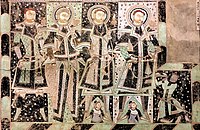The US FDA’s proposed rule on laboratory-developed tests: Impacts on clinical laboratory testing
Contents
Appearance
 | |
| Location | Xinjiang, China |
|---|---|
| Coordinates | 41°47′30″N 82°53′55″E / 41.791667°N 82.898611°E |
The Kizilgaha Caves (simplified Chinese: 克孜尔尕哈石窟; traditional Chinese: 克孜爾尕哈石窟; pinyin: Kèzīěrgǎhā shíkū) consist in a Buddhist Temple inside a complex of caves in the area of Kucha, Xinjiang, China. The paintings in the cave go back to the 5th century CE.[1] Other famous sites nearby are the Ah-ai Grotto, Kizil Caves, Kumtura, Subashi Temple and the Simsim caves.[2]
Gallery
-
Kizilgaha beacon tower
-
Donors in Tocharian clothing, Kizilgaha cave 14, Kucha
-
Donors in Tocharian clothing, Kizilgaha, cave 30.
References
- ^ Yamauchi, Kazuya; Taniguchi, Yoko; Uno, Tomoko; Conservation, Japan Center for International Cooperation in (2007). Mural Paintings of the Silk Road: Cultural Exchanges Between East and West : Proceedings of the 29th Annual International Symposium on the Conservation and Restoration of Cultural Property, National Research Institute for Cultural Properties, Tokyo, January 2006. Archetype. p. 35. ISBN 978-1-904982-22-7.
- ^ (Other than Kizil)... "The nearby site of Kumtura contains over a hundred caves, forty of which contain painted murals or inscriptions. Other cave sites near Kucha include Subashi, Kizilgaha, and Simsim." in Buswell, Robert E.; Lopez, Donald S. (24 November 2013). The Princeton Dictionary of Buddhism. Princeton University Press. p. 438. ISBN 978-1-4008-4805-8.




















